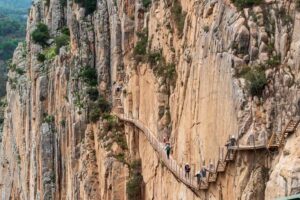The Itinerary of the French Way was established in the 11th century, thanks to the efforts of Sancho III the Great, Sancho Ramírez of Navarre and Aragon, Alfonso VI, and other Kings of Castile, Leon, and Galicia.
The Camino de Santiago enters the Iberian Peninsula from the North (Pyrenees, where the famous Song of Roland took place during its retreat to France with his uncle Charlemagne), through four routes from France: the Toulouse Way (starting from Arles), the Le Puy Way (beginning in Le Puy), the Limusin Way (originating in Vezelay and passing through Limoges), and the Turonense Way (from Paris with a stop in Tours).
Three of these routes: Paris-Tours, Vézelay-Limoges, Le Puy-Conques, cross the Pyrenees through Roncesvalles, defining the Navarrese Way. The fourth: Arles-Toulouse, does so through Somport and continues to Jaca, known as the “Aragonese Way”.
The itinerary of the French Way, with a distance of 770 kilometers, is undoubtedly the most popular, with more Jacobean tradition and more frequented by pilgrims from all corners of the world. Recognized as the first European Cultural Itinerary and becoming a World Heritage Route in 2004. The start of the route in Spanish territory is from the town of Roncesvalles, crossing Pamplona and joining the Aragonese Way in Puente la Reina (Navarre). This area is characterized by its beech and pine forests, the scent of grapes, as well as its vast and dense plains, reaching the mountains of Galician oaks and chestnuts.

Índice de contenidos
Historic and legendary cities arise along our journey
Estella/Lizarra, where the Relics of Saint Andrew deserve special mention and a mandatory stop; Logroño, Nájera, with the famous Collegiate Church of Santa María La Real; Burgos, a nucleus of great interest on the Way. Other relevant cities include: Santo Domingo de La Calzada with its famous legend of the rooster, and Castrojeriz.
Once in the Palencia area, Frómista will enchant us with its Romanesque Church of San Martín; Carrión de los Condes, with the spectacular Monastery of San Zoilo (home to the best Gothic cloister in the world), and finally Sahagún with its lively Cluniac history.
We arrive in León with the magnificent Gothic of its Cathedral and the Romanesque frescoes of the Royal Pantheon of San Isidoro.
On our way to Galician lands, we reach the city of Astorga where the French Way converges with the Silver Route and with the still-present trace of the Romans’ passage through the Peninsula and Gaudí’s art.

In Ponferrada, a Templar bastion, we can visit its imposing Castle.
If our strength prevents us from continuing our pilgrimage, in Villafranca del Bierzo we can request indulgence and Jubilee at the Church of Santiago, as it has enjoyed that privilege since ancient times. It is known as the “little Compostela”, and in the Holy Year 2021, we can make use of this privilege.
Before our arrival in Galicia, we enter the magical Valcarce Valley, where the mythical Castles of Sarracin and Autares are located.
Galicia is entered through the mountain pass of O Cebreiro (birthplace of the legend of the Galician Holy Grail), where its views will captivate us, despite being one of the toughest stages of the French Way from Villafranca del Bierzo to O Cebreiro.
From the heights, we have “only” 152 km left to our long-awaited destination, Santiago de Compostela and its Cathedral, eagerly awaiting us to welcome us and give us the long-awaited hug to the Apostle Santiago.
If the entire route of the French Way is of great interest to all pilgrims, the section with the highest influx and concentration of pilgrims is from Sarria to Santiago, as









